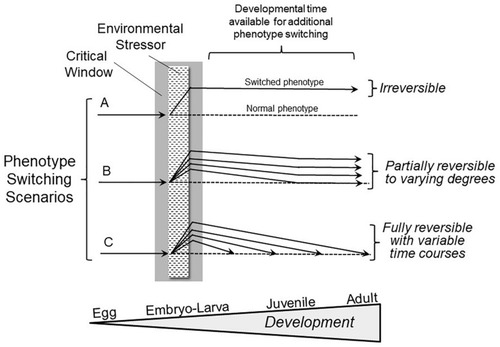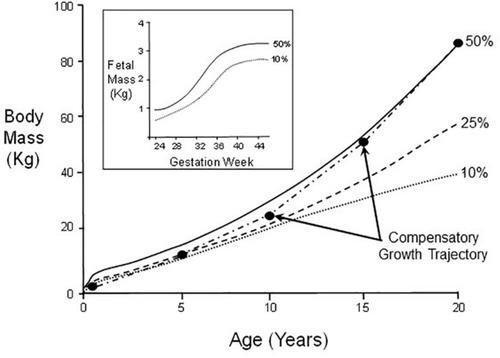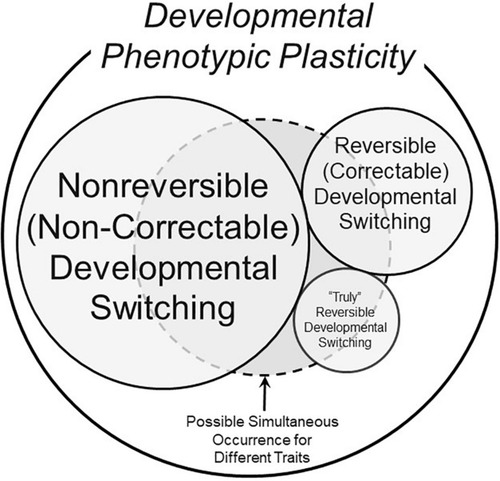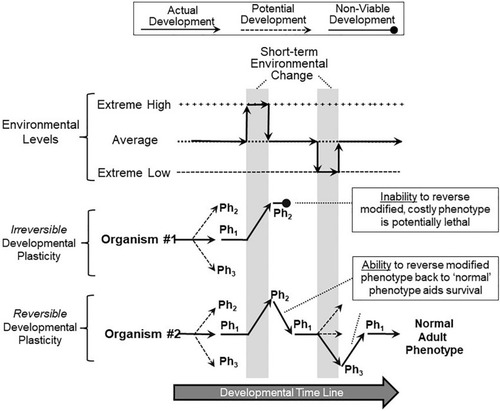- Title
-
Phenotypic Switching Resulting From Developmental Plasticity: Fixed or Reversible?
- Authors
- Burggren, W.W.
- Source
- Full text @ Front. Physiol.
|
Hypothetical outcomes involving phenotype switching scenarios following exposure to adverse environments during critical windows in development. Scenario A shows the conventional, highly discussed condition of irreversible switching of phenotype induced by an environmental stressor during the critical window. Scenario B depicts a far less frequently studied situation of phenotypic switching initiated during a critical window that, in fact, is reversible to varying degrees. Scenario C indicates that there may be complete reversibility of phenotypic modifications occurring at varying rates during subsequent development. The extent and rate of phenotype reversal may relate to the extent of the difference between the altered and normal (typical) juvenile/adult phenotypes. Importantly, either a single trait might show different degrees of reversibility, or multiple traits could show a range of degrees of reversal to the normal phenotype. |
|
Body mass changes in male humans between birth and age 20. Indicated are growth curves for 50th, 25th, and 10th percentiles of the population. A hypothetical example of catch-up growth is also indicated. Inset: Fetal mass as a function of gestation week for 50th and 10th percentiles. |
|
A schematic of possible components of the overall phenomenon of developmental phenotypic plasticity. This Venn diagram makes the assumption that not all phenotypic changes induced by stressors during developmentally critical windows are non-reversible (non-correctable) – see text for further discussion of definitions. The different sizes of the circles and text are meant to convey the very approximate prevalence of the form of developmental switching. The dashed circle represents the fact that all three types of developmental phenotypic switching could occur simultaneously in an animal, each for a different trait. |
|
Implications of reversible and non-reversible developmental phenotypic plasticity. In this scenario, two organisms are tracked during their development as they experience multiple, short-term extreme environmental changes (vertical gray bars). Both Organism #1 (red) and Organism #2 (blue) respond to the first extreme environmental change by switching from their normal range of phenotypes (Ph1) to a specialized, adaptive phenotype (Ph2) that allows continued survival in that environment. However, Organism #1, lacking the ability to reverse (correct) its phenotype that was suitable for the extreme high environment, is now non-viable when the environment reverts back to more typical conditions as development continues. Organism #2, which similarly responded to the first environmental change with a switched phenotype (Ph2), has the ability to reverse or correct the costly or even lethal modified phenotype back to normal ranges (Ph1) when the environment returns to normal, aiding its survival. Organism #2 can also move to other phenotypes (Ph3) and revert back to normal ranges (Ph1) as subsequent environmental swings occur. Thus, in this overall scenario, reversible phenotypic switching during development heavily favors survival of the developing organism. |




